Motion UI Design is an essential part of user experience design, as it provides a visual feedback for users and makes the user interface easier to interact with. Motion UI helps bring life to an interface and can be used in many different ways to create a fun, engaging, and intuitive experience. Understanding motion UI design will help you make your user interfaces even more immersive and effective.

Motion UI design is becoming increasingly popular in the world of user interface design. It is an effective way to create engaging experiences that keep users hooked and provide an intuitive flow. Motion UI combines sophisticated animations with sound, transitioning images, and other creative elements. At its core, motion UI focus on simplicity and usability. By using well executed transitions with subtle yet powerful features, motion UI can give your product a professional appearance that can make all the difference between success and failure.
Motion UI involves elements such as animation, transitions, parallax scrolling and 3D effects. Animation is the primary element used to create dynamic visuals that draw users in. Transitions provide a smooth transition between two states or pages without any additional coding required. Parallax scrolling gives the illusion of depth in a flat 2D layout by moving layers of images at differentspeed when the user scrolls. Finally, 3D effects give an extra layer of realism to objects on screen by adding realistic lighting, shadows and reflections.

When implementing motion UI remember to focus on making it purposeful instead of overpowering, since too much movement can be distracting for users. It should also be designed to match your brand identity – keep colours and visual styles consistent throughout your application interfaces to create a cohesive experience for the user. In addition, make sure you optimise your animations for different device sizes and check that they remain smooth whatever speed users scroll or swipe at – animation stutters can cause performance issues such as delays or crashes on slow devices.

Many modern websites utilize motion UI to create seamless transitions as visitors move throughout their site. Often this type of design creates a feeling of anticipation as each element slowly slides into place. When done right, this transition can give an elegant feel to webpages or applications allowing them to stand out among competitors. Another important factor in a successful Motion UI experience is its speed. Smooth curves paired with sudden jumps can create excitement while allowing users to quickly access content they are looking for rather than waiting for the page to load or elements to appear.
In addition, motion graphics have been increasingly used in mobile applications where gestures are key components of user interactions. For example, mobile app designers use parallax scrolling techniques to enhance the appearance of transition – when two layers move at different speeds – creating uniqueness in their designs While basic functionality may be achieved without using motion graphics, using well executed Motion UI elements from the beginning could greatly speed up user interaction times by eliminating small delays across multiple screens or pages for menu navigation purposes. As more people visit sites via tablets and phones, motion UI becomes even more important since it skips developers having to worry about how basic page loading works on these devices thereby resulting in a better overall performance and improved user experience

Ultimately, Motion UI design provides a great platform for websites and apps alike; it could improve both interactivity and aesthetics while allowing developers more control over various aspects of their work based solely on interactions between graphical elements alone—ideal for innovative designs that require complex sets of animation visuals difficult or almost impossible achieve through code only. With Motion UI being so flexible and adaptable, there’s no reason not to give it a try when developing or creating interactive experiences –it’s sure to take your project up a notch!
In conclusion Motion UI has become an important UX tool that allows designers to create more meaningful experiences by bringing life into applications while maintaining a refined look. By following best practices such as using purposeful movement, staying consistent with branding stylesand testing performance extensively
you’ll ensure successful implementation of Motion UI designs in your projects!
